The neoclassical buildings are the evidence, the living proofs of the history of an area, often imbued with elements of local architecture but always sculpted in the context of neoclassicism, with its principles and characteristics governing them. The protection and renovation of the neoclassical buildings is a vital issue for the transmission of our culture to the next generations, a project that encounters several difficulties in the modern urban landscape of a city like Pyrgos in the Peloponnese.
The changes that took place in Europe during the nineteenth century resulted in a frantic demographic explosion that was reflected in the arts and especially architecture. During the Industrial Revolution, rural people in Western Europe moved en masse to the cities. In this context of urbanization, the classicism that originated from the ancient Greek architecture emerges. The new organization of life inspires architects to build new types of buildings governed by the principles of neoclassicism, which are dominated by symmetry but a new theme emerges, which is inspired by classical antiquity. Such buildings are the administrative buildings, highways, railway stations, universities, libraries, stock exchanges and various other architectures.
Undoubtedly, the rapid prevalence and spread of neoclassicism in Greece is due to King Otto who was an ardent supporter. Therefore, it is logical for Athens to be overwhelmed very quickly by neoclassical buildings and to create a school. In the cities of the rest of Greece, neoclassical buildings are being built at a fast pace. One of these cities is Pyrgos.
Pyrgos is located in the Peloponnese and is the capital of the prefecture of Ilia, just 20 km from Ancient Olympia, which is the place where the Olympic Games were born in antiquity. Brilliant mansions adorn the city of Pyrgos and show the prosperity that characterized it, as well as testify to the connection of the city with raisins, which was the main export during the decades 1830-1860, as ships full of raisins departed from the nearby port. of Katakolo to the ports of Western Europe and mainly England.
The quality of the Peloponnese raisins is distinguished in these countries and will be used in various activities such as making pudding, raisin bread, drinks and as a nut. The ground floors of several mansions that began to be built after the liberation from the Ottomans will be used as storage facilities for raisin production.
In the city of Pyrgos, several neoclassical buildings have the property of being arranged around a central courtyard. On the outside we can see a stone or marble base, the ceramic decoration, capitals, acrokerama, capes and in some cases statues. Foreign architects such as Ziller also prevailed in the City of the Tower, passing on their art to Greek craftsmen and architects. Ernst Ziller left an indelible mark in the prefecture of Ilia with great works such as The Museum of Ancient Olympia, the Archaeological Museum of Pyrgos, the Railway Station of Pyrgos and the Railway Station of Ancient Olympia, the “Apollon” Theater of Pyrgos and the “Manolopouleio” Hospital.
There are many buildings in the city of Pyrgos with special value. These centers of memory must not be lost to the wear and tear of time and our indifference or to natural disasters.
The elected have a historical debt that they must pay off by protecting the cultural heritage and preserving the historical identity of a city.
Neoclassical buildings in Pyrgos
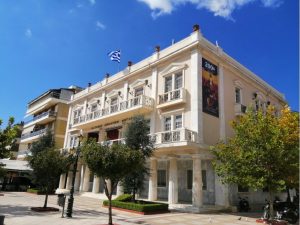
Neoclassical building with imposing architecture that adorns the central square of the city is the “Latsio Municipal Palace”. It was built with a donation from the shipowner Ioannis Latsis. The space houses the services of the Municipality of Pyrgos, the Office of the Mayor and the President of the Municipal Council, the meeting room of the Municipal Council, as well as the room that hosts the Folklore Exhibition. The facade of the building with rich morphological elements mimics classicist patterns.
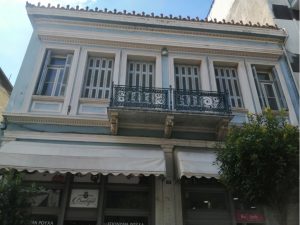
Neoclassical buildings can be maintained in city centers, used for commercial use as shopping malls, museums, libraries, banks and as upgraded buildings that will host public services. An important element in repairing the damage of a neoclassical building is the respect for the original architectural design of the building and the preservation of its style. In the picture we see a typical example of a successful renovation with the exterior of the building shining in blue and white.
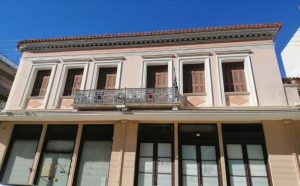
In contrast to the Baroque style, neoclassicism is characterized by absolute symmetry of facades, Doric and Ionic order, a vertical axis can divide the building into two equal parts. In the picture we see a typical example of proper renovation of a neoclassical mansion in the city of Pyrgos.
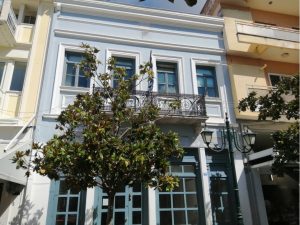
The neoclassical structures form the cultural identity of several Greek and European cities. The neoclassical building in the photo is located in the central square of Pyrgos and as we observe its condition is excellent.
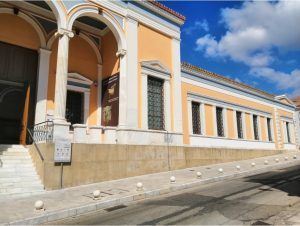
The Archaeological Museum of Pyrgos, an exceptional two-storey work of classical architecture by Ernst Ziller, is the most important listed building in the city. Several ceramics designed by E. Ziller such as: acrokerama, skulls, columns, plasterboards, vases influenced the architects of neoclassicism in Greece and used them as standard designs in their works.
-------------------------------------------
By: kostisg
Title: The cultural wealth of the neoclassicial buildings of the Greek city of Pyrgos
Sourced From: www.neweurope.eu/article/the-cultural-wealth-of-the-neoclassicial-buildings-of-the-greek-city-of-pyrgos/
Published Date: Mon, 07 Feb 2022 20:24:39 +0000
Read More
Did you miss our previous article...
https://badpoliticians.com/uk-politics/india-must-get-rid-of-all-its-debts-by-implementing-smart-and-secure-governance
 UK PoliticsWorld PoliticsVideosPrivacy PolicyTerms And Conditions
UK PoliticsWorld PoliticsVideosPrivacy PolicyTerms And Conditions
